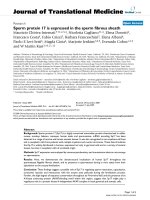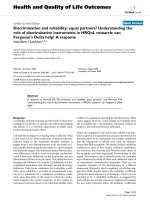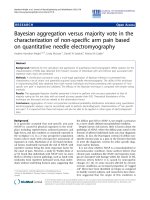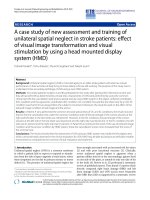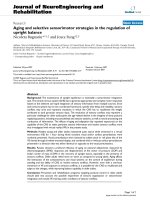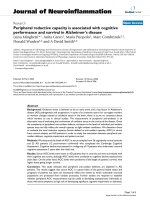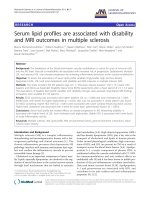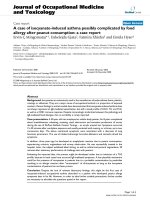báo cáo hóa học:" A MIF haplotype is associated with the outcome of patients with severe sepsis: a case control study" pdf
Bạn đang xem bản rút gọn của tài liệu. Xem và tải ngay bản đầy đủ của tài liệu tại đây (275.56 KB, 8 trang )
BioMed Central
Page 1 of 8
(page number not for citation purposes)
Journal of Translational Medicine
Open Access
Research
A MIF haplotype is associated with the outcome of patients with
severe sepsis: a case control study
Lutz E Lehmann
†1
, Malte Book*
†1
, Wolfgang Hartmann
2
, Stefan U Weber
3
,
Jens-Christian Schewe
3
, Sven Klaschik
3
, Andreas Hoeft
3
and Frank Stüber
1
Address:
1
University Department of Anaesthesiology and Pain Therapy, Inselspital, CH-3010 Bern, Switzerland,
2
Department of Pathology, Bonn
University, Sigmund-Freud-Str. 25, D-53105 Bonn, Germany and
3
Clinic and Policlinic for Anaesthesiology and Operative Intensive Care, Bonn
University, Sigmund-Freud-Str. 25, D-53105 Bonn, Germany
Email: Lutz E Lehmann - ; Malte Book* - ; Wolfgang Hartmann - wolfgang.hartmann@uni-
bonn.de; Stefan U Weber - ; Jens-Christian Schewe - ;
Sven Klaschik - ; Andreas Hoeft - ; Frank Stüber -
* Corresponding author †Equal contributors
Abstract
Background: Macrophage migration inhibitory factor (MIF) plays an important regulatory role in
sepsis. In the promoter region a C/G single nucleotide polymorphism (SNP) at position -173
(rs755622) and a CATT
5-8
microsatellite at position -794 are related to modified promoter activity.
The purpose of the study was to analyze their association with the incidence and outcome of severe
sepsis.
Methods: Genotype distributions and allele frequencies in 169 patients with severe sepsis, 94
healthy blood donors and 183 postoperative patients without signs of infection or inflammation
were analyzed by real time PCR and Sequence analysis. All included individuals were Caucasians.
Results: Genotype distribution and allele frequencies of severe sepsis patients were comparable
to both control groups. However, the genotype and allele frequencies of both polymorphisms were
associated significantly with the outcome of severe sepsis. The highest risk of dying from severe
sepsis was detectable in patients carrying a haplotype with the alleles -173 C and CATT
7
(p =
0.0005, fisher exact test, RR = 1,806, CI: 1.337 to 2.439).
Conclusion: The haplotype with the combination of the -173 C allele and the -794 CATT
7
allele
may not serve as a marker for susceptibility to sepsis, but may help identify septic patients at risk
of dying.
Background
Macrophage Migration Inhibitory Factor (MIF) is a
cytokine widely expressed in both immune and non-
immune cells playing an essential role in the pathophysi-
ology of host immune and inflammatory responses [1,2].
After discovery for its name-giving activity of inhibiting
the random migration of peritoneal macrophages [3], MIF
was rediscovered as a hormone-like factor secreted by
macrophages, anterior pituitary cells, and endothelial
cells activating both macrophages and T-lymphocytes [4-
7]. MIF was shown to be induced rather than suppressed
by glucocorticoids and to have a capacity to override the
Published: 26 November 2009
Journal of Translational Medicine 2009, 7:100 doi:10.1186/1479-5876-7-100
Received: 19 June 2009
Accepted: 26 November 2009
This article is available from: />© 2009 Lehmann et al; licensee BioMed Central Ltd.
This is an Open Access article distributed under the terms of the Creative Commons Attribution License ( />),
which permits unrestricted use, distribution, and reproduction in any medium, provided the original work is properly cited.
Journal of Translational Medicine 2009, 7:100 />Page 2 of 8
(page number not for citation purposes)
anti-inflammatory and immunosuppressive effects of glu-
cocorticoids [8]. Moreover, MIF was discovered to be
involved in the regulation of cell membrane expression of
TLR4, which mediates recognition of Gram-negative bac-
teria [9]. Also, MIF was shown to influence immuno-reg-
ulatory processes by indirectly affecting the
transcriptional activity of nuclear transcription factor AP-
1 [10]. The role of MIF in Gram-negative sepsis was
reviewed by Roger and colleagues [11] and updated by
Emonts and co workers [12]. Circulating concentrations
of MIF were markedly elevated in children and adults who
had severe sepsis or septic shock [12]. Circulating MIF lev-
els are correlated with sepsis severity scores, presence of
shock, disseminated intravascular coagulation, urine out-
put, blood pH, and lactate and cytokine levels [12]. More-
over, high levels of circulating MIF are associated with a
fatal outcome [12,13].
Consequently, MIF has been a relevant candidate gene for
investigation in inflammatory disease and studies focus-
ing on elucidation of MIF gene expression have been
undertaken. Two functionally relevant promoter poly-
morphisms of the MIF gene have been described. A single
nucleotide polymorphism (SNP) was identified in the
untranslated 5' region of the MIF gene at position -173
consisting of a G to C transition (rs755622) [14]. Moreo-
ver, a tetranucleotide (CATT)
5-8
repeat was found at posi-
tion -794 [15]. Functional studies of both polymorphic
sites have revealed altered MIF protein expression in vitro.
Donn and co workers reported about the functional rele-
vance of the -173 promoter SNP [16], whereas Baugh and
co workers detected the -794 microsatellite and reported
about the influence of the number of CATT repeats on the
promoter activity [15]. In a large study Radstake and co
workers reported the association of the -173 C allele and
the -794 CATT
7
microsatellite independently from each
other with elevated circulating MIF levels in patients with
rheumatoid arthritis [17]. Subsequently, higher MIF levels
are correlated with more severe radiological joint damage
[17].
The aim of this study was to evaluate the association of the
MIF-173 G/C SNP and the MIF -794 CATT
5-8
microsatel-
lite with severe sepsis compared to healthy blood donors
and patients with abdominal surgery but without signs of
infection or inflammation. Secondly, an evaluation of the
association of the MIF polymorphisms with the survival
of severe sepsis patients was performed.
Methods
The investigation was in compliance with the Helsinki
declaration. After approval of the local ethics committee
and written informed consent of the patient or a legal
guardian had been obtained, 169 Caucasian patients with
the diagnosis of severe sepsis according to the consensus
conference [18] were included in the study. SOFA [19]
scores were calculated, IL-6 and Procalcitonin (PCT)
plasma levels were measured after the patients fulfilled
criteria for severe sepsis. All patients were treated accord-
ing to the surviving sepsis campaign guidelines [20]. Staff
physicians were blinded of the patient's MIF genotype to
avoid any bias in therapy. Two independent control
groups were sampled, also: a) 183 Caucasian patients fol-
lowing major elective abdominal surgery without infec-
tious or inflammatory complications and without post-
operative ICU admission. b) 94 Caucasian healthy blood
donors. All included individuals were Caucasians from
Germany.
For genotyping of the MIF -173 promoter SNP 3.2 ml of
whole blood were collected from each individual. DNA
was prepared using the Flexi Gene DNA Kit (Qiagen,
Hilden, Germany) according to the manufacturer's rec-
ommendations. Genotyping was done using a real-time
PCR based system (LightCycler by Roche, Mannheim,
Germany) with hybridization probes specific for the MIF
-173 SNP. The PCR primer pair comprised of forward
primer: 5' GGCTTCATCTCTGGAAGGGTAA, and reverse
primer: 5' CAGCAACCGTCGCTAAGC. The sequence for
the MIF -173 SNP specific hybridization anchor probe
was: 5' GGCGGCTAGAAATCGGCCTGT. The sequence for
the MIF -173 G/C SNP specific sensor probe was: 5'
GCTCCAAGCTGTTCTCCAC. The anchor probe was phos-
phorylated at the 3' end and carried a LightCycler Red 640
(Roche) dye at the 5' end. The sensor probe was labeled by
Fluorescein dye at the 5' end. Primers and probes were
designed in cooperation with TIB-MOLBIOL (Berlin, Ger-
many) and manufactured by this company. In brief the
PCR was done using 45 cycles of 5 sec denaturation at
95°C, 8 sec annealing at 60°C and 8 sec of primer exten-
sion at 72°C. Subsequent melting curve analysis for deter-
mination of the MIF genotype was done with an initial 20
sec denaturation at 95°C, followed by an 60 sec annealing
at 50°C and a final ramp to 85°C with continuous fluo-
rescence acquisition at a transition rate of 0.1°C/sec.
Additionally, individual samples representing the G/G, G/
C or C/C genotypes as analyzed by real-time PCR were
also genotyped by DNA sequencing to control for the
accuracy of the real-time PCR method. All controlled sam-
ples had matching results between real-time PCR and
DNA sequencing.
Genotyping of the MIF -794 microsatellite was performed
analyzing a 130-142 bp PCR fragment covering a known
CATT repeat in the 5'untranslated region of the gene.
Primers used were MIF forward 5-TGTCCTCTTCCT-
GCTATGTC 3, and MIF reverse 5-CACTAATGGTAAA CT
CGGGG-3. The MIF reverse primer was 5-labeled with a
fluorescent dye (5-FAM; MWG Biotech, Munich, Ger-
many). The PCR program consisted of an initial denatur-
Journal of Translational Medicine 2009, 7:100 />Page 3 of 8
(page number not for citation purposes)
ation for 5 min at 94°C followed by 34 cycles of 35 sec
denaturation at 94°C, 40 sec annealing at 62°C, 40 sec
extension at 72°C and a final extension step of 10 min at
72°C. The reaction products were analyzed on a semiau-
tomated DNA sequencer (ABI 377) equipped with the
Genescan software (ABI, Darmstadt, Germany). The coin-
cidence of the -173 C allele and the -794 CATT
7
microsat-
ellite was described as an inferred haplotype.
Statistical analysis of genotype distribution and allele fre-
quency was done by chi-square Test and Fischer's exact
Test where applicable. The analysis of statistical differ-
ences of SOFA score and plasma levels (IL-6, PCT) was
done by Mann-Whitney-U test. Bonferroni correction was
applied for single marker analysis. Statistical significance
was assumed at p < 0.05. Statistical power (1-β) was calcu-
lated using binominal power calculation. The power cal-
culation for the -173 SNP and the -794 microsatellite
based on investigations by Amoli and Baugh [15,21]. The
relative risks of 2.1 and 1.56 were taken as a basis for effect
sizes of a -173 and a -794 allele, respectively. Both relative
risks were transferred from the mentioned publications
[15,21]. The prevalence of severe sepsis was estimated to
be 0.01. Using these preconditions the power of the pre-
sented results for the -173 G/C SNP and the -794 (CATT)
n
microsatellite was 98% and 87%, respectively. The linkage
disequilibrium of the two loci was assessed with the open
source application TASSEL2.1 zegenet
ics.net. The association between the C and the CATT
7
allele was assessed with a Fisher's exact test.
Results
169 Patients with severe sepsis were studied (121 male
and 48 female). 94 healthy blood donors and 183
patients after abdominal surgery without post-operative
signs of infection or inflammation, without ICU admis-
sion and without case of death within the first postopera-
tive 28 days served as two separate control groups.
Furthermore, local wound infection rates reflected overall
infection rates of this group of patients. The baseline char-
acteristics of the both patient groups are outlined in Table
1. The mean age of healthy blood donors was 34 (18 to
56) and the female to male ratio was 37 to 57.
When dividing the severe sepsis patients in surviving (n =
91) and non-surviving patients (n = 78), mean SOFA
score, as well as IL-6 plasma levels were significantly
higher in non-surviving patients compared to survivors
(Table 2). However, PCT plasma levels were comparable
between the two groups (Table 2).
The allele CATT
8
was neither detectable in the patients'
group nor in either of the control groups. The genotype
distribution and allele frequencies for the -173 SNP and
the -794 microsatellite were comparable between the
severe sepsis patients and the two control groups (p >
0.05, chi square test). There was no evidence of deviation
from the Hardy-Weinberg equilibrium in the patient and
control groups (p > 0.05, chi square test). Table 3 shows
the genotype and allele distribution of both polymor-
phisms in the three groups. The carriage of the allele -
173C was significantly associated with carriage of the -794
CATT
7
microsatellite (Fisher's exact test, p < 0.0001, RR =
8.398, CI: 6.187 to 11.40). Moreover, both polymor-
phisms are in linkage disequilibrium (D' = 0.779).
The genotype and allele frequencies of both polymor-
phisms were significantly different between survivors and
non-survivors of severe sepsis (Table 3, -173 SNP geno-
type frequency: p = 0.0218, -173 SNP allele frequency: p =
0.0398, -794 microsatellite genotype frequency: p =
0.0016, -794 microsatellite allele frequency: p = 0.0174,
chi-square test and Fischer's exact Test, respectively, all
Bonferroni corrected).
Carrying the C allele of the -173 SNP resulted in a relative
risk of 1.598 (CI: 1.165 to 2.193, p = 0.013, Fisher's exact
test Bonferroni corrected, power: 1-β = 0.81) for a poor
outcome of severe sepsis. Independently from the -173
SNP, the carriage of the -794 CATT
7
allele showed a rela-
tive risk of 1.839 (CI: 1.360 to 2.488, p = 0.0006, Fisher's
exact test Bonferroni corrected, power: 1-β = 0.96) for
Table 1: Baseline characteristics of patients with severe sepsis and patients with abdominal surgery without signs of infection or
inflammation (* unpaired t test, ** Fisher's exact test).
Severe Sepsis
(n = 169)
Abdominal surgery
without infection/inflammation (n = 183)
p-value
Age (years) 58 (18 - 91) 56 (20 - 85) 0.16 *
Female:Male (n) 48 : 121 75 : 108 0.014 **
Source of infection
Pulmonary (n) 67 n.a.
Abdominal (n) 61 n.a.
Other/unknown (n) 41 n.a.
Mortality (%) 46.2 0
Age is presented as mean and range of values. (n.a.: not applicable)
Journal of Translational Medicine 2009, 7:100 />Page 4 of 8
(page number not for citation purposes)
death due to severe sepsis compared to patients without
allele CATT
7
. The concomitance of the -173 allele C and
the -794 allele CATT
7
as a haplotype was significantly
associated with non-survival of severe sepsis (p = 0.0005,
Fischer exact Test, RR = 1.806, CI: 1.337 to 2.439, power:
1-β = 0.91). Table 3 indicates the number of patients car-
rying the haplotype consisting of the -173 C and the -794
CATT
7
allele. Accordingly, these patients display the -173
SNP C/C or G/C genotype in combination with the -794
microsatellite 5/7, 6/7 or 7/7 genotype, respectively.
Table 4 indicates the association of the carriage of the -173
C allele and the -794 CATT
7
allele with fatal outcome in
patients with severe sepsis which are grouped by the cov-
ariates "gender", "age", and "focus of infection". In the
groups "female", "male", " ≤ 60 years old", and non-pul-
monary and non-abdominal focus, carriage of -173 C
allele and -794 CATT
7
allele is associated with fatal out-
come (table 4).
Discussion
The -794 MIF microsatellite is located in the promoter
region and has functional relevance probably due to mod-
ified binding of nuclear transcription factors [22]. The rel-
evance of the -794 microsatellite was assessed
inconsistently with regard to analyzed cell types [15,22].
Just as well as the -794 microsatellite, the MIF -173 pro-
moter SNP is of special interest because of its functional
relevance. Donn and co workers detected increased pro-
moter activity of the G allele compared to the C allele in
an unstimulated lung epithelia cell line [16]. However, in
the same work the authors reported about increased pro-
moter activity of the C allele compared to the G allele in
an also unstimulated T lymphoblast cell line [16]. The
MIF plasma levels in -173 C carrying individuals were
higher compared to non C carrying individuals [16]. Tem-
ple and co workers published about unstimulated and
bacterial stimulated mononuclear cells in which allele -
173 C occurrence resulted in decreased constitutive and
inducible MIF mRNA levels [22]. This illustrates the com-
plexity of the functional role of promoter polymorphisms
in a comparatively simple ex vivo setting. Previous own
results showed elevated MIF plasma levels in patients with
severe sepsis as well as in patients with systemic inflam-
mation compared to healthy controls [23].
Recent publications reported about the association of the
-173 C allele with inflammatory diseases such as rheuma-
toid arthritis [17,24], inflammatory bowel diseases [25],
and its clinical course [26]. The relevance of the C/C gen-
otype was confirmed in Chinese patients with ulcerative
colitis but not Crohn's disease [27]. The -794 microsatel-
lite is also related to inflammatory diseases such as atopy
[28], asthma [29], and rheumatoid arthritis [15]. Finally,
the correlation of the -173 C allele and the -794 CATT
7
allele as a haplotype with scleroderma [30], systemic
lupus erythematosus [31] and with the susceptibility to
psoriasis [32] was reported. A very recent publication
reported about an association of -173 C allele carriage
with lower 90 d mortality in a severe sepsis subgroup of
patients with community-acquired pneumonia (CAP)
which seems to be a contradiction to the presented results
[33]. It has to be pointed out that Yende et al. reported a
90 day mortality rate of 27.2% in the severe sepsis sub-
group which was lower compared to the 28 day mortality
rate in the presented study (46.2%). This indicates that
there might be elementary differences between both pop-
ulations. Moreover, the independency of circulating MIF
levels from the alleles is contradictory to previous reports
[16]. Previous investigations in a Columbian population
and Kenyan children showed the association (i) of the -
173 C allele with tuberculosis and (ii) of the -173 C allele
in combination with the -794 CATT
7
microsatellite with
severe malarial anemia, respectively [34,35]. These find-
ings seem to be in line with our results reporting deleteri-
ous effects of these markers in infectious diseases.
However, as discussed by Yende and co workers these dif-
ferences may reflect the clinical heterogeneity in patients
with infectious diseases. Finally, Yende and co workers
recruited their individuals in the northeastern United
States, whereas our patients and controls were from west-
ern Germany origin. Although both investigations
included Caucasians genetic differences might contribute
to the divergent results.
An approach to explain our findings might be the
increased promoter activity combined with increased MIF
plasma levels as reported by Donn and co workers for the
-173 C allele. This might increase cardiomyocyte apopto-
sis as reported in an animal sepsis model [36]. In addi-
tion, MIF was associated with dysregulated pituitary-
Table 2: Survivors and non-survivors of severe sepsis showed differences in SOFA score and IL-6 plasma level analyzed at the diagnosis
of severe sepsis whereas PCT levels showed no significant differences (Mann-Whitney-U test).
Survivors (n = 91) Non-Survivors (n = 78) p-value
SOFA Score 11 (7-20) 16 (14-22) 0.0256
IL-6 (pg/ml) 1677 (15-31860) 6497 (264-70361) 0.0098
PCT (ng/ml) 19.44 (9.45-46.49) 22.08 (2.03-246.1) 0.052
Data are presented as mean and range of values.
Journal of Translational Medicine 2009, 7:100 />Page 5 of 8
(page number not for citation purposes)
Table 3: 173 and -794 genotype and allele distribution in the study population.
-173 -794 Haplotype
Study
groups
Genotype Allele Genotype Allele
G/G G/C C/C p = G C p = 5/5 5/6 5/7 6/6 6/7 7/7 p = 5 6 7 p = -173 C
and -794
CATT
7
positive
-173 C
and -794
CATT
7
negative
p =
Healthy
Controls
(n = 94)
63 28 3 0.67 154 34 0.859 4 25 8 39 18 0 0.123 41 121 26 0.0451
Abdominal
surgery
without
infection or
inflammation
(n = 183)
123 54 6 300 66 7 55 7 75 35 4 76 240 50
Severe
sepsis
(n = 169)
106603 27266 15501854284 9818654
Survivors
sev. Sepsis
(n = 91)
66 23 2 0.022 155 27 0.039 12 28 7 35 6 3 0.0016 59 104 19 0.0174 15 76 0.0005
Non-
Survivors
sev. Sepsis
(n = 78)
40 37 1 117 39 3 22 11 19 22 1 39 82 35 32 46
The 169 patients with severe sepsis are separated by surviving or non-surviving in the lower two rows. Genotype and allele distribution of healthy controls, patients with abdominal surgery, and
patients with severe sepsis were tested by chi square test. Survivors and non-survivors of severe sepsis were also tested by chi square and Fischer's exact test where applicable, results were
Bonferroni corrected. Incidence of the alleles -173 C and -794 CATT
7
was associated with non-surviving severe sepsis (p = 0.0005, Fisher exact Test, RR = 1,806, CI: 1.337 to 2.439).
Journal of Translational Medicine 2009, 7:100 />Page 6 of 8
(page number not for citation purposes)
adrenal function in sepsis [12] and fatal outcome of severe
sepsis [37].
The relevance of MIF polymorphisms in patients with sep-
sis was addressed only by association studies, so far. Gao
and co workers reported about an association of the -173
SNP genotype C/C with the incidence of sepsis in African
Americans but not in European Americans [38]. However,
because of the limited sample size of -173 C/C individuals
in Gao's investigation, this effect was assessed to be under-
powered [38]. The number of individuals with the -173 C/
C genotype in the present study is small as well and in the
investigated Caucasian patients and control groups no sig-
nificant association of the C/C genotype with the inci-
dence of severe sepsis was detectable. It could be assumed,
that different races might contribute to inconsistent asso-
ciations due to different haplotype blocks. Gao and co
workers reported about a haplotype in the European-
descent American population which consists of the -173
promoter SNP, the promoter SNP rs9282783, the intron
SNP rs2070777, the intergenic SNPs rs875643 and
rs1007889 and the SNP rs2070767 which is located
downstream of the 3' untranslated region [38]. Our results
showed linkage disequilibrium between the two polymor-
phisms. This is in line with findings from Temple and co
workers as well as Yende and co workers [22,33]. In addi-
tion, Temple and co workers reported the significant asso-
ciation of the -173 C allele with the -794 CATT
7
allele [22],
which was supported by our data. Generally, investiga-
tions analysing candidate genes in selected phenotypes
can not exclude the detection of significant associations
which are functionally inconsiderable but are in linkage
disequilibrium with possibly undetected causative vari-
ants. However, there is some evidence for a functional
impact of the investigated polymorphisms as pointed out
above.
In the sepsis patient sub groups female and male patients
as well as patients with age ≤60 years and in patients with
non-pulmonary or non-abdominal focus the haplotype
was associated with poor outcome whereas in older
patients and in the groups defined by the focus of sepsis it
was not. Especially in the younger patient group the effect
of genetic predisposition might be stronger because of the
fewer incidences of other confounders influencing the
outcome. For example serious co-existing diseases like
pulmonary, vascular or heart disease are well known as
important comorbidities in the elderly. The association in
the sub group with non-abdominal, non-pulmonary sep-
sis focus might be caused by higher influence of genetic
predisposition in a group which is least ill reflected by the
lowest mortality rate.
It is a general limitation of association studies that it is
impossible to decide whether the investigated SNP has
functional meaning or is in linkage disequilibrium with
another, yet not identified variant which might be causal
for functional implications. To date there are numerous
reports indicating associations of SNPs with the inci-
dence, course or outcome in sepsis or severe sepsis
patients [39-43]. Although the SNPs are located within
genes and some of them showed functional relevance in
an ex vivo setting it is not for sure the case in a complex sit-
uation as in vivo blood stream infection.
Another serious point frequently addressed to association
studies is the statistical power. The design of the present
study included 169 patients with severe sepsis, 94 healthy
Table 4: Incidence of carrying the alleles -173 C and -794 CATT
7
was associated with non-surviving severe sepsis in female and male
patients, patients younger as 61 years old and patients with non-abdominal and non-pulmonary focus of sepsis.
Patients with severe
sepsis sub groups
Sup group Mortality (%) Association of allele carriage -173 C and -794 CATT
7
and sub group status
with fatal outcome
pRRCI
Gender
Female (n = 48) 47.9 0.0135 2,182 1.251 to 3.805
Male (n = 121) 45.5 0.0267 1,635 1.126 to 2.373
Age
≤ 60 y (n = 84) 41.7 0.0007 2,400 1.541 to 3.737
> 60 y (n = 85) 50.6 0.635 1,159 0.7499 to 1.790
Focus of infection
Pulmonal (n = 67) 41.8 0,2312 1,514 0.8559 to 2.679
Abdominal (n = 61) 62.3 0,1734 1,337 0.9228 to 1.937
Other/unknown
(n = 41)
29.3 0,0066 3,818 1.527 to 9.549
RR: Relative risk; CI: Confidence interval
Journal of Translational Medicine 2009, 7:100 />Page 7 of 8
(page number not for citation purposes)
controls and 183 surgical patients without infectious
complications. 91 patients with severe sepsis survived and
78 patients died. Based on the allele, genotype and haplo-
type frequencies, on the fraction of non-surviving patients
and on the genotype relative risks the statistical power of
the significant associations were 81%, 96% and 91%,
respectively. The relative risks of -173 and -794 alleles and
genotypes reported by Baugh and Amoli [15,21] showed
that the two polymorphisms have considerable high effect
sizes for certain phenotypes. Our results confirmed these
findings. The relative risks for poor outcome of the two
polymorphisms and combination of both were 1.6, 1.84
and 1.80. This effect size was in line with the data pub-
lished by Baugh and Amoli [15,21].
Conclusion
The present study investigated for the first time the associ-
ation of the MIF -173 promoter SNP and the MIF -794
CATT
5-8
microsatellite with the incidence and outcome of
severe sepsis by the comparison with two control groups.
Our data indicate that neither alleles or genotypes of the -
173 SNP variant nor of the -794 microsatellite were asso-
ciated with the incidence of severe sepsis. However, at
positions -173 and -794 alleles and genotypes were asso-
ciated with survival of severe sepsis when analyzed sepa-
rately as well as analyzed as a haplotype. Especially in the
sub group of patients ≤60 years old and in patients with
non-abdominal and non-pulmonary sepsis focus the
association with poor outcome was pronounced. Of note,
the common observation in both groups was the
decreased mortality rate compared to the entire severe
sepsis group. Therefore, in patients with severe sepsis and
especially in younger patients with other than abdominal
or pulmonary focus the MIF-173 G/C SNP and the -794
CATT
5-8
microsatellite may not serve as markers for sus-
ceptibility to sepsis, but may well contribute to identify
those septic patients at risk of dying.
List of Abbreviations
AP-1: Activator protein-1; CI: Confidence interval; ICU:
Intensive care unit; IL-6: Interleukin-6; MIF: Macrophage
migration inhibitory factor; n.a.: not applicable; PCR:
Polymerase chain reaction; PCT: Procalcitonin; RR: Rela-
tive risk; SNP: Single nucleotide polymorphism; SOFA:
Sequential Organ Failure Assessment; TLR4: Toll like
receptor 4.
Competing interests
The authors declare that they have no competing interests.
Authors' contributions
LEL planned the study, recruited patients, performed gen-
otyping and drafted the manuscript. MB Performed statis-
tical calculations, wrote the manuscript, contribute to
patient inclusion and study design. WH contributed to
study design, performed genotyping and drafted the man-
uscript. SUW contributed to patient inclusion, data analy-
sis and drafted the manuscript. JCS contributed to patient
inclusion and study design and drafted the manuscript. SK
contributed to patient inclusion, genotyping and drafted
the manuscript. AH contributed to study design, statistical
calculations and drafted the manuscript. FS planned the
study, supervised genotyping and statistical calculations,
coordinated the study and drafted the manuscript. All
authors read and approved the final manuscript
Acknowledgements
The authors would like to thank Sabine Mering for expert technical assist-
ance with the genotyping assay.
References
1. Baugh JA, Bucala R: Macrophage migration inhibitory factor.
Crit Care Med 2002, 30:S27-S35.
2. Calandra T, Roger T: Macrophage migration inhibitory factor:
a regulator of innate immunity. Nat Rev Immunol 2003,
3:791-800.
3. David JR: Delayed hypersensitivity in vitro: its mediation by
cell-free substances formed by lymphoid cell-antigen inter-
action. Proc Natl Acad Sci USA 1966, 56:72-77.
4. Bacher M, Metz CN, Calandra T, Mayer K, Chesney J, Lohoff M,
Gemsa D, Donnelly T, Bucala R: An essential regulatory role for
macrophage migration inhibitory factor in T-cell activation.
Proc Natl Acad Sci USA 1996, 93:7849-7854.
5. Bernhagen J, Calandra T, Mitchell RA, Martin SB, Tracey KJ, Voelter
W, Manogue KR, Cerami A, Bucala R: MIF is a pituitary-derived
cytokine that potentiates lethal endotoxaemia. Nature 1993,
365:756-759.
6. Calandra T, Bernhagen J, Mitchell RA, Bucala R: The macrophage
is an important and previously unrecognized source of mac-
rophage migration inhibitory factor. J Exp Med 1994,
179:1895-1902.
7. Nishihira J, Koyama Y, Mizue Y: Identification of macrophage
migration inhibitory factor (MIF) in human vascular
endothelial cells and its induction by lipopolysaccharide.
Cytokine 1998, 10:199-205.
8. Calandra T, Bernhagen J, Metz CN, Spiegel LA, Bacher M, Donnelly T,
Cerami A, Bucala R: MIF as a glucocorticoid-induced modulator
of cytokine production. Nature 1995, 377:68-71.
9. Roger T, David J, Glauser MP, Calandra T: MIF regulates innate
immune responses through modulation of Toll-like receptor
4. Nature 2001, 414:920-924.
10. Kleemann R, Hausser A, Geiger G, Mischke R, Burger-Kentischer A,
Flieger O, Johannes FJ, Roger T, Calandra T, Kapurniotu A, Grell M,
Finkelmeier D, Brunner H, Bernhagen J: Intracellular action of the
cytokine MIF to modulate AP-1 activity and the cell cycle
through Jab1. Nature 2000, 408:211-216.
11. Roger T, Glauser MP, Calandra T: Macrophage migration inhibi-
tory factor (MIF) modulates innate immune responses
induced by endotoxin and Gram-negative bacteria.
J Endo-
toxin Res 2001, 7:456-460.
12. Emonts M, Sweep FC, Grebenchtchikov N, Geurts-Moespot A,
Knaup M, Chanson AL, Erard V, Renner P, Hermans PW, Hazelzet JA,
Calandra T: Association between high levels of blood macro-
phage migration inhibitory factor, inappropriate adrenal
response, and early death in patients with severe sepsis. Clin
Infect Dis 2007, 44:1321-1328.
13. Chuang CC, Wang ST, Chen WC, Chen CC, Hor LI, Chuang AY:
Increases in serum macrophage migration inhibitory factor
in patients with severe sepsis predict early mortality. Shock
2007, 27:503-506.
14. Donn RP, Shelley E, Ollier WE, Thomson W: A novel 5'-flanking
region polymorphism of macrophage migration inhibitory
factor is associated with systemic-onset juvenile idiopathic
arthritis. Arthritis Rheum 2001, 44:1782-1785.
15. Baugh JA, Chitnis S, Donnelly SC, Monteiro J, Lin X, Plant BJ, Wolfe
F, Gregersen PK, Bucala R: A functional promoter polymor-
Publish with Bio Med Central and every
scientist can read your work free of charge
"BioMed Central will be the most significant development for
disseminating the results of biomedical research in our lifetime."
Sir Paul Nurse, Cancer Research UK
Your research papers will be:
available free of charge to the entire biomedical community
peer reviewed and published immediately upon acceptance
cited in PubMed and archived on PubMed Central
yours — you keep the copyright
Submit your manuscript here:
/>BioMedcentral
Journal of Translational Medicine 2009, 7:100 />Page 8 of 8
(page number not for citation purposes)
phism in the macrophage migration inhibitory factor (MIF)
gene associated with disease severity in rheumatoid arthri-
tis. Genes Immun 2002, 3:170-176.
16. Donn R, Alourfi Z, De BF, Meazza C, Zeggini E, Lunt M, Stevens A,
Shelley E, Lamb R, Ollier WE, Thomson W, Ray D: Mutation
screening of the macrophage migration inhibitory factor
gene: positive association of a functional polymorphism of
macrophage migration inhibitory factor with juvenile idio-
pathic arthritis. Arthritis Rheum 2002, 46:2402-2409.
17. Radstake TR, Sweep FC, Welsing P, Franke B, Vermeulen SH, Geurts-
Moespot A, Calandra T, Donn R, van Riel PL: Correlation of rheu-
matoid arthritis severity with the genetic functional variants
and circulating levels of macrophage migration inhibitory
factor. Arthritis Rheum 2005, 52:3020-3029.
18. American College of Chest Physicians/Society of Critical
Care Medicine Consensus Conference: definitions for sepsis
and organ failure and guidelines for the use of innovative
therapies in sepsis. Crit Care Med 1992, 20:864-874.
19. Vincent JL, Moreno R, Takala J, Willatts S, De MA, Bruining H, Rein-
hart CK, Suter PM, Thijs LG: The SOFA (Sepsis-related Organ
Failure Assessment) score to describe organ dysfunction/
failure. On behalf of the Working Group on Sepsis-Related
Problems of the European Society of Intensive Care Medi-
cine. Intensive Care Med 1996, 22:707-710.
20. Dellinger RP, Carlet JM, Masur H, Gerlach H, Calandra T, Cohen J,
Gea-Banacloche J, Keh D, Marshall JC, Parker MM, Ramsay G, Zim-
merman JL, Vincent JL, Levy MM: Surviving Sepsis Campaign
guidelines for management of severe sepsis and septic shock.
Intensive Care Med 2004, 30:536-555.
21. Amoli MM, Donn RP, Thomson W, Hajeer AH, Garcia-Porrua C, Lue-
iro M, Ollier WE, Gonzalez-Gay MA: Macrophage migration
inhibitory factor gene polymorphism is associated with sar-
coidosis in biopsy proven erythema nodosum. J Rheumatol
2002, 29:1671-1673.
22. Temple SE, Cheong KY, Price P, Waterer GW: The microsatellite,
macrophage migration inhibitory factor -794, may influence
gene expression in human mononuclear cells stimulated
with E. coli or S. pneumoniae. Int J Immunogenet 2008,
35:309-316.
23. Lehmann LE, Novender U, Schroeder S, Pietsch T, von ST, Putensen
C, Hoeft A, Stuber F: Plasma levels of macrophage migration
inhibitory factor are elevated in patients with severe sepsis.
Intensive Care Med 2001, 27:1412-1415.
24. Martinez A, Orozco G, Varade J, Sanchez LM, Pascual D, Balsa A, Gar-
cia A, de la Concha EG, Fernandez-Gutierrez B, Martin J, Urcelay E:
Macrophage migration inhibitory factor gene: influence on
rheumatoid arthritis susceptibility. Hum Immunol 2007,
68:744-747.
25. Oliver J, Marquez A, Gomez-Garcia M, Martinez A, Mendoza JL,
Vilchez JR, Lopez-Nevot MA, Pinero A, de la Concha EG, Nieto A,
Urcelay E, Martin J: Association of the macrophage migration
inhibitory factor gene polymorphisms with inflammatory
bowel disease. Gut 2007, 56:150-151.
26. Nohara H, Okayama N, Inoue N, Koike Y, Fujimura K, Suehiro Y,
Hamanaka Y, Higaki S, Yanai H, Yoshida T, Hibi T, Okita K, Hinoda Y:
Association of the -173 G/C polymorphism of the macro-
phage migration inhibitory factor gene with ulcerative coli-
tis. J Gastroenterol 2004, 39:242-246.
27. Fei BY, Lv HX, Yang JM, Ye ZY: Association of MIF-173 gene pol-
ymorphism with inflammatory bowel disease in Chinese Han
population. Cytokine 2008, 41:44-47.
28. Hizawa N, Yamaguchi E, Takahashi D, Nishihira J, Nishimura M:
Functional polymorphisms in the promoter region of macro-
phage migration inhibitory factor and atopy. Am J Respir Crit
Care Med 2004, 169:1014-1018.
29. Mizue Y, Ghani S, Leng L, McDonald C, Kong P, Baugh J, Lane SJ, Craft
J, Nishihira J, Donnelly SC, Zhu Z, Bucala R: Role for macrophage
migration inhibitory factor in asthma. Proc Natl Acad Sci USA
2005, 102:14410-14415.
30. Wu SP, Leng L, Feng Z, Liu N, Zhao H, McDonald C, Lee A, Arnett
FC, Gregersen PK, Mayes MD, Bucala R: Macrophage migration
inhibitory factor promoter polymorphisms and the clinical
expression of scleroderma. Arthritis Rheum 2006, 54:3661-3669.
31. Sanchez E, Gomez LM, Lopez-Nevot MA, Gonzalez-Gay MA, Sabio
JM, Ortego-Centeno N, de RE, Anaya JM, Gonzalez-Escribano MF,
Koeleman BP, Martin J: Evidence of association of macrophage
migration inhibitory factor gene polymorphisms with sys-
temic lupus erythematosus. Genes Immun 2006, 7:433-436.
32. Donn RP, Plant D, Jury F, Richards HL, Worthington J, Ray DW, Grif-
fiths CE: Macrophage migration inhibitory factor gene poly-
morphism is associated with psoriasis. J Invest Dermatol 2004,
123:484-487.
33. Yende S, Angus DC, Kong L, Kellum JA, Weissfeld L, Ferrell R, Fine-
gold D, Carter M, Leng L, Peng ZY, Bucala R: The influence of mac-
rophage migration inhibitory factor gene polymorphisms on
outcome from community-acquired pneumonia. FASEB J
2009, 23:2403-2411.
34. Gomez LM, Sanchez E, Ruiz-Narvaez EA, Lopez-Nevot MA, Anaya JM,
Martin J: Macrophage migration inhibitory factor gene influ-
ences the risk of developing tuberculosis in northwestern
Colombian population. Tissue Antigens 2007, 70:28-33.
35. Awandare GA, Martinson JJ, Were T, Ouma C, Davenport GC,
Ong'echa JM, Wang W, Leng L, Ferrell RE, Bucala R, Perkins DJ: MIF
(macrophage migration inhibitory factor) promoter poly-
morphisms and susceptibility to severe malarial anemia. J
Infect Dis 2009, 200:629-637.
36. Dhanantwari P, Nadaraj S, Kenessey A, Chowdhury D, Al-Abed Y,
Miller EJ, Ojamaa K: Macrophage migration inhibitory factor
induces cardiomyocyte apoptosis. Biochem Biophys Res Commun
2008, 371:298-303.
37. Bozza FA, Gomes RN, Japiassu AM, Soares M, Castro-Faria-Neto HC,
Bozza PT, Bozza MT: Macrophage migration inhibitory factor
levels correlate with fatal outcome in sepsis. Shock 2004,
22:309-313.
38. Gao L, Flores C, Fan-Ma S, Miller EJ, Moitra J, Moreno L, Wadgaonkar
R, Simon B, Brower R, Sevransky J, Tuder RM, Maloney JP, Moss M,
Shanholtz C, Yates CR, Meduri GU, Ye SQ, Barnes KC, Garcia JG:
Macrophage migration inhibitory factor in acute lung injury:
expression, biomarker, and associations. Transl Res 2007,
150:18-29.
39. Shalhub S, Junker CE, Imahara SD, Mindrinos MN, Dissanaike S,
O'Keefe GE: Variation in the TLR4 gene influences the risk of
organ failure and shock posttrauma: a cohort study. J Trauma
2009, 66:115-122.
40. Sipahi T, Kuybulu A, Ozturk A, Akar N: Protein Z G79A Polymor-
phism in Patients With Severe Sepsis. Clin Appl Thromb Hemost
2009 [ />1076029608330010v1].
41. Russell JA, Wellman H, Walley KR: Protein C rs2069912 C allele
is associated with increased mortality from severe sepsis in
North Americans of East Asian ancestry. Hum Genet 2008,
123:661-663.
42. Henckaerts L, Nielsen KR, Steffensen R, Van SK, Mathieu C, Giulietti
A, Wouters PJ, Milants I, Vanhorebeek I, Langouche L, Vermeire S,
Rutgeerts P, Thiel S, Wilmer A, Hansen TK, Van den BG: Polymor-
phisms in innate immunity genes predispose to bacteremia
and death in the medical intensive care unit. Crit Care Med
2009, 37:192-193.
43. Read RC, Teare DM, Pridmore AC, Naylor SC, Timms JM, Kaczmar-
ski EB, Borrow R, Wilson AG: The tumor necrosis factor poly-
morphism TNF (-308) is associated with susceptibility to
meningococcal sepsis, but not with lethality. Crit Care Med
2009, 37:1237-1243.

